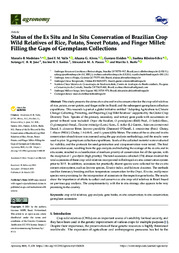Status of the ex situ and in situ conservation of brazilian crop wild relatives of rice, potato, sweet potato, and finger millet: filling the gaps of germplasm collections.
Status of the ex situ and in situ conservation of brazilian crop wild relatives of rice, potato, sweet potato, and finger millet: filling the gaps of germplasm collections.
Autoria: MEDEIROS, M. B. de; VALLS, J. F. M.; ABREU, A. G. de; HEIDEN, G.; RIBEIRO-SILVA, S.; JOSE, S. C. B. R.; SANTOS, I. R. I.; PASSOS, A. M. A. dos; BURLE, M. L.
Resumo: This study presents the status of ex situ and in situ conservation for the crop wild relatives of rice, potato, sweet potato, and finger millet in Brazil, and the subsequent germplasm collection expeditions. This research is part of a global initiative entitled ?Adapting Agriculture to Climate Change: Collecting, Protecting, and Preparing Crop Wild Relatives? supported by the Global Crop Diversity Trust. Species of the primary, secondary, and tertiary gene pools with occurrences reported in Brazil were included: Oryza alta Swallen, O. grandiglumis (Döll) Prod., O. latifolia Desv., O. glumaepatula Steud., Eleusine tristachya (Lam.) Lam., E. indica (L.) Gaertn., Solanum commersonii Dunal, S. chacoense Bitter, Ipomoea grandifolia (Dammer) O?Donell, I. ramosissima (Poir.) Choisy, I. tiliacea (Willd.) Choisy, I. triloba L., and I. cynanchifolia Meisn. The status of the ex situ and in situ conservation of each taxon was assessed using the gap analysis methodology, and the results were used to plan 16 germplasm collection expeditions. Seeds of the collected material were evaluated for viability, and the protocols for seed germination and cryopreservation were tested. The final conservation score, resulting from the gap analysis and including the average of the ex situ and in situ scores, resulted in a classification of medium priority of conservation for all the species, with the exception of I. grandifolia (high priority). The total accessions collected (174) almost doubled the total accessions of these crop wild relatives incorporated in Embrapa?s ex situ conservation system prior to 2015. In addition, accessions for practically absent species were collected for the ex situ conservation system, such as Ipomoea species, Eleusine indica, and Solanum chacoense. The methods used for dormancy breaking and low temperature conservation for the Oryza, Eleusine, and Ipomoea species were promising for the incorporation of accessions in the respective gene banks. The results show the importance of efforts to collect and conserve ex situ crop wild relatives in Brazil based on previous gap analysis. The complementarity with the in situ strategy also appears to be very promising in the country.
Ano de publicação: 2021
Tipo de publicação: Artigo de periódico
Unidade: Embrapa Arroz e Feijão
Observações
1 - Por padrão são exibidas publicações dos últimos 20 anos. Para encontrar publicações mais antigas, configure o filtro ano de publicação, colocando o ano a partir do qual você deseja encontrar publicações. O filtro está na coluna da esquerda na busca acima.
2 - Para ler algumas publicações da Embrapa (apenas as que estão em formato ePub), é necessário ter, no celular ou computador, um desses softwares gratuitos. Sistemas Android: Google Play Livros; IOS: iBooks; Windows e Linux: software Calibre.
Acesse outras publicações
Acesse a Base de Dados da Pesquisa Agropecuária (BDPA) para consultar o acervo completo das bibliotecas da Embrapa.

